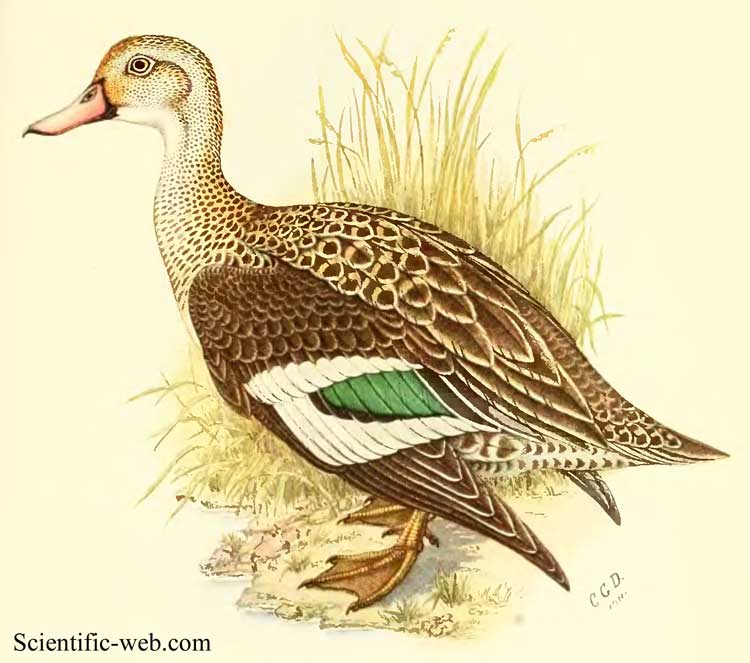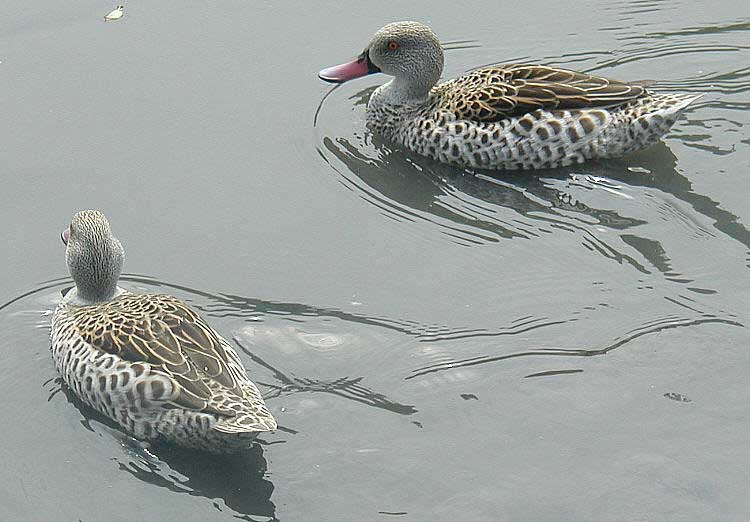
Anas capensis
Superregnum: Eukaryota
Cladus: Unikonta
Cladus: Opisthokonta
Cladus: Holozoa
Regnum: Animalia
Subregnum: Eumetazoa
Cladus: Bilateria
Cladus: Nephrozoa
Superphylum: Deuterostomia
Phylum: Chordata
Subphylum: Vertebrata
Infraphylum: Gnathostomata
Megaclassis: Osteichthyes
Cladus: Sarcopterygii
Cladus: Rhipidistia
Cladus: Tetrapodomorpha
Cladus: Eotetrapodiformes
Cladus: Elpistostegalia
Superclassis: Tetrapoda
Cladus: Reptiliomorpha
Cladus: Amniota
Classis: Reptilia
Cladus: Eureptilia
Cladus: Romeriida
Subclassis: Diapsida
Cladus: Sauria
Infraclassis: Archosauromorpha
Cladus: Crurotarsi
Divisio: Archosauria
Cladus: Avemetatarsalia
Cladus: Ornithodira
Subtaxon: Dinosauromorpha
Cladus: Dinosauriformes
Cladus: Dracohors
Cladus: Dinosauria
Ordo: Saurischia
Cladus: Eusaurischia
Subordo: Theropoda
Cladus: Neotheropoda
Cladus: Averostra
Cladus: Tetanurae
Cladus: Avetheropoda
Cladus: Coelurosauria
Cladus: Tyrannoraptora
Cladus: Maniraptoromorpha
Cladus: Maniraptoriformes
Cladus: Maniraptora
Cladus: Pennaraptora
Cladus: Paraves
Cladus: Eumaniraptora
Cladus: Avialae
Infraclassis: Aves
Cladus: Euavialae
Cladus: Avebrevicauda
Cladus: Pygostylia
Cladus: Ornithothoraces
Cladus: Ornithuromorpha
Cladus: Carinatae
Parvclassis: Neornithes
Cohors: Neognathae
Cladus: Pangalloanserae
Cladus: Galloanseres
Ordo: Anseriformes
Familia: Anatidae
Genus: Anas
Species: Anas capensis
Name
Anas capensis Gmelin, 1789

Anas capensis, Photo: Adrian Pingstone
References
Gmelin, J.F. 1789. Caroli a Linné systema naturae per regna tria naturae, secundum classes, ordines, genera, species, cum characteribus, differentiis, synonymis, locis. Tomus I, Pars II. Editio decima tertia, aucta, reformata. - pp. 501–1032. Lipsiae. (Beer). DOI: 10.5962/bhl.title.545 527 n.98 BHL Reference page.
Vernacular names
Afrikaans: Teeleend
čeština: Čírka popelavá
dansk: Kapand
English: Cape Teal
Esperanto: Afrika kreko
español: Cerceta de El Cabo
français: Sarcelle du Cap
日本語: アカハシコガモ
norsk: Kappand
русский: Капский чирок
svenska: Kapand
The Cape teal (Anas capensis) also Cape wigeon or Cape widgeon is a 44–46 cm long dabbling duck of open wetlands in sub-Saharan Africa.
Taxonomy
The Cape teal was formally described in 1789 by the German naturalist Johann Friedrich Gmelin in his revised and expanded edition of Carl Linnaeus's Systema Naturae. He placed it with all the ducks, geese and swans in the genus Anas and coined the binomial name Anas capensis.[2] Gmelin based his description on the "Cape widgeon" that had been described in 1785 by the English ornithologist John Latham in his A General Synopsis of Birds. The naturalist Joseph Banks had provided Latham with a drawing of the duck from the Cape of Good Hope.[3][4] The genus name Anas is the Latin word for a duck. The specific epithet capensis indicates the Cape of Good Hope.[5] The species is monotypic: no subspecies are recognised.[6]
Description
AnasCapensisSmit.jpg
Like many southern ducks, the sexes are similar. It is very pale and mainly grey, with a browner back and pink on the bill (young birds lack the pink). This is a generally quiet species, except during mating displays. The breeding male has a clear whistle, whereas the female has a feeble "quack". The Cape teal cannot be confused with any other duck in its range.
This species is essentially non-migratory, although it moves opportunistically with the rains. It is a thinly distributed but widespread duck, rarely seen in large groups except the moulting flocks, which may number up to 2000.
The Cape teal feeds on aquatic plants and small creatures (invertebrates, crustaceans and amphibians)[7] obtained by dabbling. The nest is on the ground under vegetation and near water.
The Cape teal is one of the species to which the Agreement on the Conservation of African-Eurasian Migratory Waterbirds (AEWA) applies.
References
BirdLife International (2016). "Anas capensis". IUCN Red List of Threatened Species. 2016: e.T22680145A92846056. doi:10.2305/IUCN.UK.2016-3.RLTS.T22680145A92846056.en. Retrieved 12 November 2021.
Gmelin, Johann Friedrich (1789). Systema naturae per regna tria naturae : secundum classes, ordines, genera, species, cum characteribus, differentiis, synonymis, locis (in Latin). Vol. 1, Part 2 (13th ed.). Lipsiae [Leipzig]: Georg. Emanuel. Beer. p. 527.
Latham, John (1785). A General Synopsis of Birds. Vol. 3, Part 2. London: Printed for Leigh and Sotheby. p. 519, no. 64.
Mayr, Ernst; Cottrell, G. William, eds. (1979). Check-List of Birds of the World. Vol. 1 (2nd ed.). Cambridge, Massachusetts: Museum of Comparative Zoology. p. 466.
Jobling, James A. (2010). The Helm Dictionary of Scientific Bird Names. London: Christopher Helm. pp. 46, 89. ISBN 978-1-4081-2501-4.
Gill, Frank; Donsker, David; Rasmussen, Pamela, eds. (January 2022). "Screamers, ducks, geese & swans". IOC World Bird List Version 12.1. International Ornithologists' Union. Retrieved 4 July 2022.
Hockey, P.A.R., Dean, W.R.J., Ryan, P.G. (Eds). 2005. Roberts – Birds of Southern Africa, VIIth ed. The trustees of the John Voelcker bird book fund, Cape Town.
Retrieved from "http://en.wikipedia.org/"
All text is available under the terms of the GNU Free Documentation License

